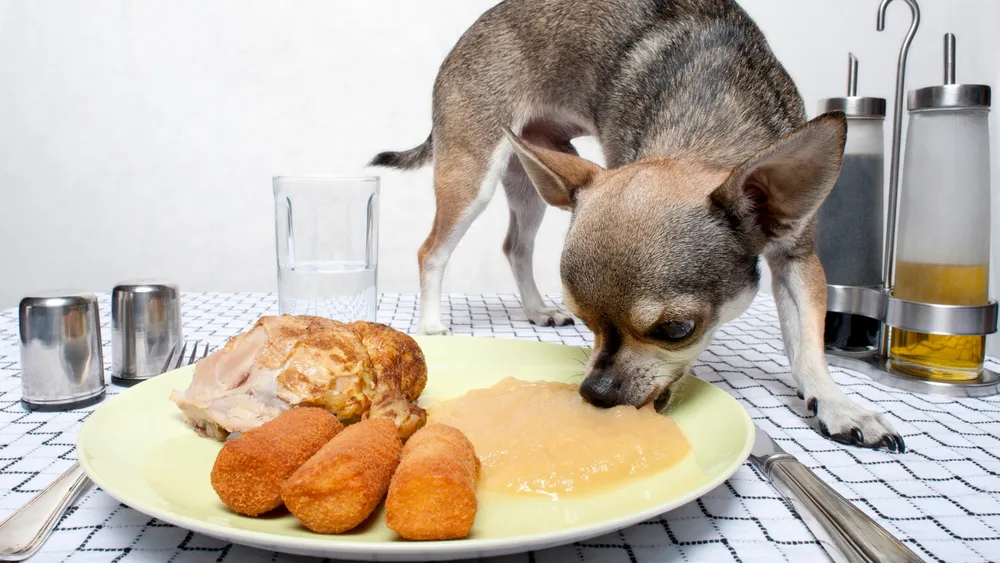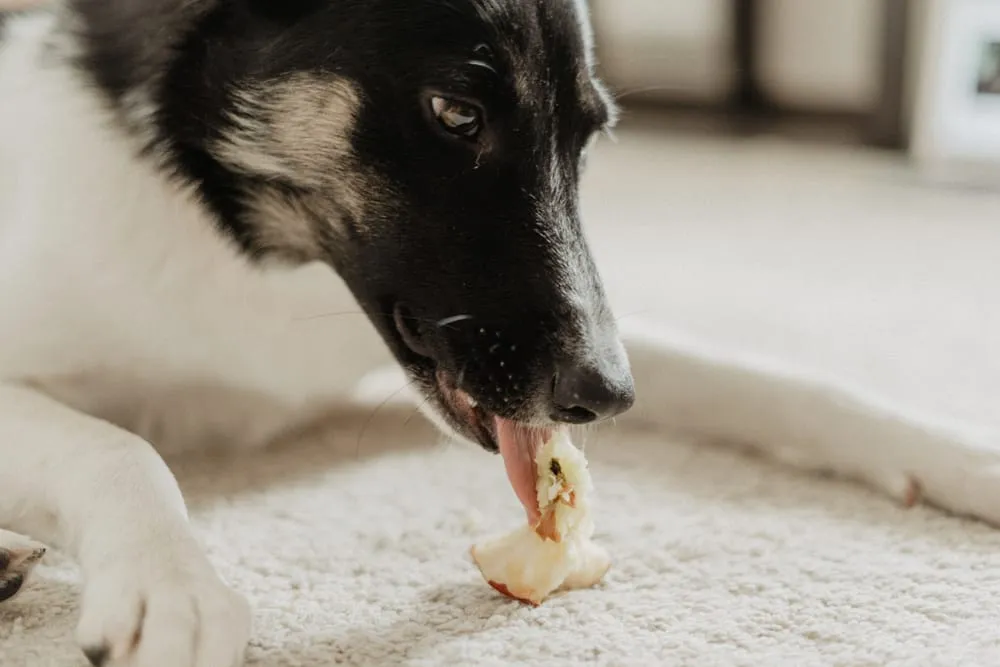Have you ever found your dog's favorite treats tucked away under the sofa or buried in the backyard? This peculiar behavior, often amusing and sometimes perplexing, is a window into the complex world of canine behavior. Dogs, with their rich emotional and psychological tapestry, exhibit a variety of behaviors that stem from both their ancestral past and their current interactions with humans and their environment. Among these behaviors, the act of hiding food is particularly fascinating.

It prompts us to delve deeper into their world, to uncover the layers of instinct, emotion, and thought that drive such actions. This article seeks to explore the multifaceted reasons behind why dogs hide their food, shedding light on the intricate interplay of genetics, environment, and psychology that shapes our furry companions' behavior. Through understanding the "why," we can foster a deeper connection and empathy towards our canine friends, appreciating the depth of their actions beyond the surface level.
Historical Context and Natural Instincts
The story of our canine companions stretches back thousands of years, from their origins as wild animals to their present status as beloved members of our households. The domestic dog, Canis lupus familiaris, diverged from its wild relatives, such as wolves, through a process of natural selection and human intervention. This long journey from the wilderness into our homes has left an indelible mark on their behavior, including the instinct to hide food.
In the wild, survival hinges on not just the ability to find food, but to secure and store it against scarcity. This instinct, deeply ingrained in their DNA, manifests in our domestic dogs as well. Despite the abundance of food in many modern households, the primal urge to prepare for potential famine persists. This behavior is a direct inheritance from their ancestors, who would cache surplus food to ensure a meal was always available, especially in harsh conditions.
A comparative glance at wolves, the closest relatives to our domestic dogs, offers insights into this behavior. Wolves, living in the demanding environments of the wild, often bury part of their kill to hide it from scavengers and to save it for later consumption. This ensures they have a backup food source when hunting is lean. Similarly, other canids like foxes and jackals display comparable food caching behaviors, driven by the same survival imperatives.
This evolutionary backdrop sheds light on why our domestic dogs, far removed from the survival challenges of their ancestors, still feel the compulsion to hide their food. It's a fascinating reminder of their ancient lineage and the wild spirit that still resides within, even in the coziest of homes. Understanding this link to their past helps us appreciate the depth and complexity of our dogs' behaviors, recognizing them as echoes of a wilder time.
Psychological Factors
The act of hiding food in dogs is not merely a remnant of their evolutionary past but is also deeply rooted in their psychological makeup. At the core of this behavior are the intertwined instincts of security and survival, which drive dogs to take measures that ensure their well-being in the face of perceived threats or uncertainties. This instinctual behavior is a testament to their innate desire to secure resources, a fundamental aspect of survival for any species.
Anxiety and stress play significant roles in exacerbating food-hiding behaviors. Dogs that have experienced scarcity, whether in the formative weeks of their lives or during periods of neglect, may develop heightened anxieties around food availability. This insecurity manifests as a need to hide food, a behavior driven by the fear that it may not be readily available in the future. Similarly, past traumas related to food competition or deprivation can leave a lasting imprint on a dog's psyche, compelling them to take preventive measures by caching food.

Resource guarding, a behavior where dogs protect their food, toys, or other valuables from others, is closely linked to food hiding. This behavior stems from a combination of natural instincts and learned experiences. In a domestic setting, it might be triggered by competition with other pets or even perceived threats from humans. For dog owners, understanding and recognizing the signs of resource guarding is crucial. It is not merely about asserting dominance or control but a complex emotional response tied to the dog's sense of security and survival.
Addressing these psychological factors requires a compassionate and empathetic approach. Building a trusting relationship, ensuring a stable and stress-free environment, and providing consistent access to resources can alleviate the anxieties that fuel food hiding. Recognizing the underlying psychological motivations behind this behavior allows dog owners to respond more effectively, fostering a sense of security and well-being for their canine companions.
Environmental Influences
The environment in which a dog lives plays a pivotal role in shaping its behaviors, including the tendency to hide food. The dynamics of a home, from the physical space to the daily routines, can significantly influence this instinctual behavior. Factors such as feeding schedules, the availability of food, and even the presence of other pets can either exacerbate or mitigate the need a dog feels to stash away its meals.
Feeding schedules that are irregular can cause anxiety in dogs, leading them to hide food out of uncertainty about when their next meal will come. Consistency in feeding times provides a sense of security, reducing the impulse to cache food. Similarly, the manner in which food is presented, whether it is freely available or rationed, can impact this behavior. Homes where food is constantly accessible may see less food hiding, as the dog feels less pressured to save for later. However, this is not a one-size-fits-all situation, as some dogs might still hide food due to ingrained instincts or other psychological factors.

The presence of other pets, especially in multi-animal households, can also contribute to food hiding. Dogs may feel the need to compete for resources, leading to behaviors aimed at securing food for future consumption. This is particularly pronounced in homes where pets are not fed separately, triggering a dog's instinct to protect its share.
Creating an environment that minimizes food hiding involves understanding these dynamics and adjusting routines and spaces accordingly. This could mean establishing consistent feeding schedules, ensuring each pet has its own feeding area, and providing an environment that feels safe and secure to the dog. By doing so, owners can help reduce the compulsion their pets feel to hide food, fostering a more relaxed and trusting atmosphere in the home.
Health and Nutrition
The diet and feeding habits of our canine friends are more intricately connected to their behavior than one might initially think. The act of hiding food, while often rooted in instinct, can also be influenced by a dog's nutritional status and feeding regimen. A well-balanced diet, tailored to a dog's specific needs, can significantly impact their inclination to stash away meals for later.
Dogs fed irregularly or with varying quantities might feel a sense of uncertainty about their next meal, prompting them to hide food as a security measure. Similarly, diets lacking in essential nutrients might drive dogs to compulsively save food, possibly as an instinctual response to perceived scarcity. This behavior underscores the importance of a consistent and nutritionally complete feeding schedule, which can provide dogs with a sense of stability and abundance, reducing the need to cache food.
Excessive food hiding can sometimes signal underlying health issues. For instance, dogs suffering from digestive problems might hide food due to discomfort associated with eating. In contrast, conditions like anxiety or obsessive-compulsive disorder can manifest in repetitive behaviors, including food hiding. It's crucial for dog owners to observe their pets' behaviors closely and consult a veterinarian if they notice excessive or unusual hiding habits, as this could be a cry for help or an indication of health problems.
To mitigate the tendency to hide food, veterinarians and canine nutritionists often recommend consistent feeding schedules, portion control, and diets formulated to meet all of a dog's nutritional needs. Engaging dogs in interactive feeding practices, such as using puzzle feeders, can also redirect the mental energy driving the hiding behavior into more constructive outlets. By understanding the nutritional underpinnings of food hiding, owners can take proactive steps to ensure their dogs are both physically and mentally satisfied, thereby reducing the compulsion to hide food and promoting a happier, healthier life for their furry companions.

Training and Management Strategies
Addressing and modifying a dog's food hiding behavior can be achieved through thoughtful training and management strategies. These methods aim not only to curb the immediate behavior but also to address underlying issues such as anxiety, stress, or boredom, which often contribute to such actions.
Positive reinforcement stands out as a particularly effective training method. This involves rewarding desirable behaviors, such as eating food without hiding it, with treats, praise, or playtime, thereby encouraging the dog to repeat these actions. The key is consistency and timing; rewards must be given immediately after the desired behavior to ensure the dog makes the correct association.
Environmental enrichment plays a crucial role in managing food hiding behavior. Providing a stimulating environment that engages a dog's senses and intellect can significantly reduce the occurrence of unwanted behaviors. Puzzle feeders, for instance, not only make mealtime more engaging but also redirect the dog's focus from hiding food to solving the puzzle to access their meal. Such tools satisfy the dog's natural foraging instincts in a constructive manner, reducing the impulse to hide food.
Preventing resource guarding, a behavior where dogs aggressively protect their food or toys, is essential for a healthy relationship with food. This involves gradually desensitizing the dog to the presence of humans and other pets near their food bowl, using methods like approaching and adding more food to the bowl while they eat. This helps the dog associate these approaches with positive outcomes, reducing fear and aggression.
Lastly, it's important for dog owners to establish a routine that includes regular feeding times, portions appropriate to the dog's size and energy needs, and a calm, secure eating environment. Such practices reassure the dog of food availability, reducing the need to hide food as a precaution against scarcity.
Incorporating these strategies into a dog's routine can significantly improve their relationship with food, leading to a happier and more balanced life for both the dog and its owner.
Conclusion
Exploring the reasons behind why dogs hide food unveils the intricate layers of canine behavior, deeply rooted in their evolutionary past and influenced by their current environments and psychological state. This journey underscores the importance of empathy and patience in addressing and modifying such behaviors.
Consistent, positive reinforcement training and creating a nurturing environment are key to managing these natural instincts. Understanding the "why" behind our dogs' actions enriches the human-dog relationship, fostering a deeper bond and mutual respect. By appreciating and addressing the complexities of canine behavior, we enhance the harmony and joy shared with our beloved companions.

FAQs
- Q: Is it normal for all dogs to hide food?
- A: While not all dogs exhibit food hiding behavior, it is relatively common and can be considered normal, especially among dogs with certain predispositions or those living in multi-pet households.
- Q: What should I do if my dog starts hiding food?
- A: Observe the behavior to determine its frequency and potential triggers. Ensure your dog is on a regular feeding schedule and has a secure eating space. If the behavior persists or is accompanied by signs of anxiety or aggression, consider consulting a veterinarian or a dog behaviorist.
- Q: Can food hiding lead to health problems?
- A: In some cases, yes. If hidden food goes unnoticed and spoils, it could lead to gastrointestinal issues if consumed later. Additionally, excessive hiding behavior might indicate underlying stress or anxiety that could impact overall well-being.
- Q: How can I prevent my dog from hiding food?
- A: Provide a stable and predictable environment with structured feeding times. Use interactive feeders to engage their mind and satisfy their foraging instincts in a healthy way. Positive reinforcement training can also help modify this behavior.
- Q: Is food hiding a sign of mistreatment or past trauma?
- A: Not necessarily. While past experiences can influence behavior, food hiding is often driven by instinctual behavior. However, if accompanied by other signs of distress, it might warrant further investigation into the dog's background and emotional state.




